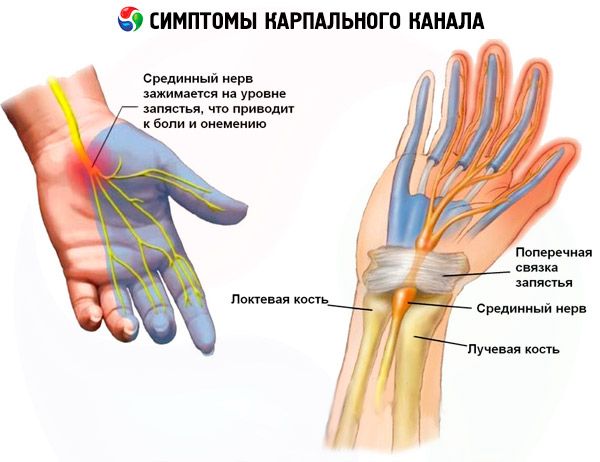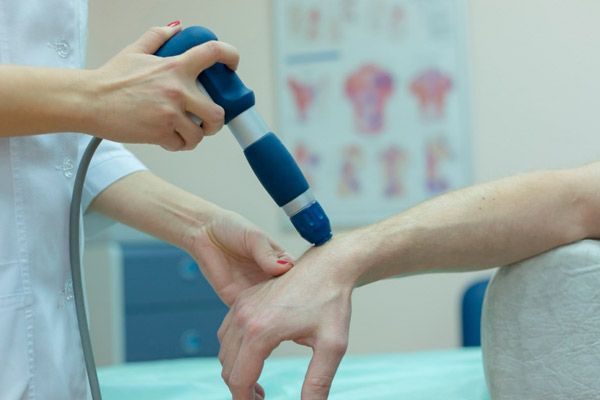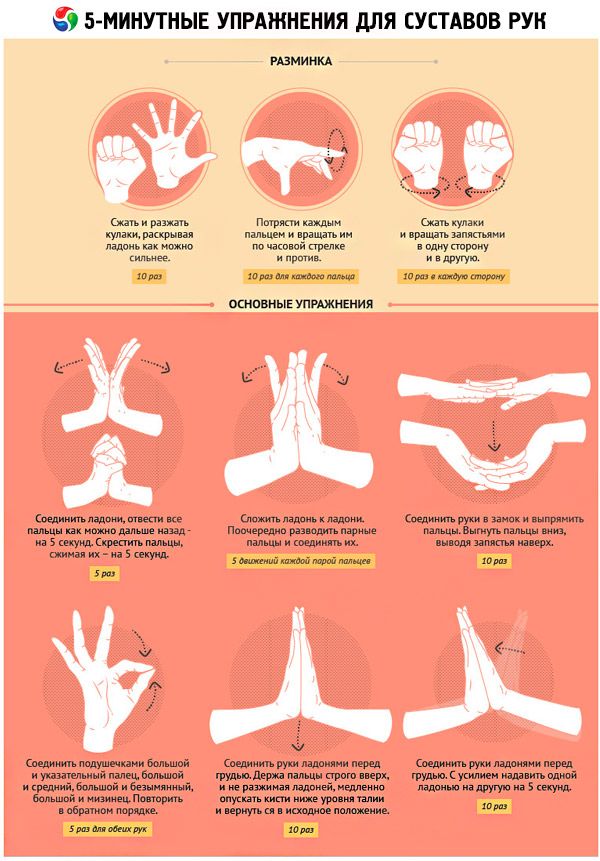
All iLive content is medically reviewed or fact checked to ensure as much factual accuracy as possible.
We have strict sourcing guidelines and only link to reputable media sites, academic research institutions and, whenever possible, medically peer reviewed studies. Note that the numbers in parentheses ([1], [2], etc.) are clickable links to these studies.
If you feel that any of our content is inaccurate, out-of-date, or otherwise questionable, please select it and press Ctrl + Enter.
Carpal tunnel syndrome
Medical expert of the article
Last reviewed: 04.07.2025
When talking about tunnel syndrome or wrist syndrome, they mean carpal tunnel syndrome - this is a pathological pinching or compression of the nerve that is responsible for the sensitivity of the palmar surface of the hand.
This disease is considered a threshold and requires mandatory treatment. Otherwise, irreversible changes in the affected nerve may occur, which over time will lead to a complete loss of sensitivity in the palm and some degenerative disorders.
Epidemiology
As we have already said, carpal tunnel syndrome is considered a fairly common pathology. Most patients are women, and the incidence rate in men is approximately 10%.
The disease can begin regardless of age characteristics. However, the majority of cases occur during the period of fading hormonal activity, that is, after 45 years. Among the total number of patients, you can find patients under 30 years old. But, as a rule, there are 15 times fewer of them than older people.
Causes carpal tunnel syndrome
Carpal tunnel syndrome begins to develop when there are provoking circumstances that cause a decrease in its diameter or swelling - something that leads to compression of the nerve. The immediate causes include:
- injury to the wrist joint, followed by swelling or hematoma;
- violation of the integrity of the wrist bone;
- inflammatory process in the wrist joint;
- neoplasms protruding into the carpal canal;
- inflammatory process in the tendons of muscle flexors;
- other causes of soft tissue swelling of the upper limbs (diabetes mellitus, hypothyroidism, etc.).
The most common cause is considered to be tenosynovitis of the flexor muscles of the wrist, which can be a consequence of physical overexertion of the hand.
Risk factors
Analyzing the above-mentioned causes of the syndrome, we can identify the corresponding risk factors:
- vascular diseases;
- diseases of tendons and ligaments;
- tendon sheath cysts;
- calcifications;
- arthritis and pseudoarthrosis;
- infectious diseases.
Among the systemic pathologies that can cause the development of carpal tunnel syndrome are diseases of the endocrine system, autoimmune diseases, and polyneuropathy.
Pathogenesis
The median nerve is formed from the fibers of the 4 spinal nerve roots that participate in a kind of brachial plexus network. It extends downwards along the arm and innervates the main wrist muscles, including the muscles responsible for flexion of the wrist joint and the motor ability of the thumb, index and middle fingers. Compression of the median nerve leads to deterioration of blood circulation in it, or even its blockade. Ischemia of the nerve fibers develops.

At the initial stage, only the superficial parts of the nerve are affected. However, over time, the situation worsens and affects deeper tissues. As a result, cicatricial changes appear, which provoke pain and paresthesia of the hand and fingers.
Symptoms carpal tunnel syndrome
The first signs of carpal tunnel syndrome are loss of sensitivity in the fingers, most often in the morning. Sensitivity is restored by mid-day.
A little later, the numbness spreads to all fingers except the little finger. In addition, there is pain, "goosebumps" and a feeling of heat at the fingertips.
The pain is felt throughout the entire finger, not just in the joint area.
Sometimes the symptoms listed above affect the entire hand, or even reach the elbow bend.
Unpleasant sensations can cause considerable discomfort, especially at night. As a result, insomnia may develop.
If you do light gymnastics of the upper limbs during an attack, the condition temporarily improves as a result of the restoration of impaired blood circulation.
As carpal tunnel syndrome progresses, more and more symptoms appear. Patients note weakness in the hand and some loss of coordination, they may drop objects, losing the ability to hold them with their fingers.

Every third patient with carpal tunnel syndrome experiences a change in skin tone: as a rule, the skin on the affected hand has a pale appearance.
In severe cases, with severe compression of the nerve, numbness can affect the entire arm to the elbow, and even to the shoulder joint or neck. This condition often leads to diagnostic errors, as doctors take it for signs of cervical osteochondrosis.
Forms
There are several stages of development of tunnel syndrome:
- Pain stage, when the only sign of compression of the median nerve is pain.
- The stage of numbness, which is characterized by the appearance of pain and numbness in the fingers.
- The stage of motor disorders, when movements in the hand become limited and uncoordinated.
- A stage of increasing weakness that develops against a background of pain, sensory disturbances and limited movement.
- The stage of hypotrophy, which often represents irreversible changes in tissues.
In addition, various types of carpal tunnel pathology have also been identified:
- radial nerve neuropathy;
- carpal tunnel syndrome and cubital tunnel syndrome.
This classification is adopted for a more accurate description of the disease when making a diagnosis, which makes it as detailed as possible.
Complications and consequences
Carpal tunnel syndrome cannot be classified as a pathology that is life-threatening for the patient. But a sluggish painful process can gradually lead to a significant limitation of the mobility of the affected limb. Therefore, competent treatment is considered not only desirable, but also necessary for further full activity. Only after successful qualified therapy can the prognosis of the syndrome be called favorable.
Diagnostics carpal tunnel syndrome
Collection of patient complaints, examination and palpation of problem areas of the hand. The doctor discovers decreased sensitivity of the first 3-4 fingers on the palm side. In advanced cases, muscle weakness and atrophic changes in the muscle responsible for abduction of the thumb are detected.
Special testing:
- Tinnel's test - simultaneously with tapping in the projection area of the median nerve, a tingling sensation appears in the fingers;
- Phalen's test - if you bend your wrists and raise your hands upward, you can feel numbness in your fingers for one minute;
- Vest test - if you put a pneumatic cuff on the forearm area and inflate it, the patient will feel pain and signs of numbness in the fingers.
Instrumental diagnostics:
- Electroneuromyography is a method used to visualize partial blockade of impulse conduction through the median nerve in the carpal tunnel;
- X-ray method – helps to exclude diseases of the skeletal system;
- ultrasound diagnostic method (ultrasonography) – may indicate thickening of the Lig. retinaculum and deterioration of nerve mobility;
- Magnetic resonance imaging method – allows us to detect flattening of the median nerve, which indicates its compression.
Laboratory diagnostics for carpal tunnel syndrome are practically not used, only in case of exclusion of other diseases. Such tests as OAK, OAM may indicate the presence of an inflammatory process.
Differential diagnosis
Differential diagnostics are carried out with compression neuropathy of other nerve endings, with osteochondrosis of the cervical spine (radicular syndrome C6-C7), with transient cerebral circulatory disorder, etc.
Who to contact?
Treatment carpal tunnel syndrome
Patients with uncomplicated carpal tunnel syndrome may be prescribed drug therapy, which consists of the use of anti-inflammatory medications simultaneously with fixation (immobilization) of the affected hand.
If such treatment is ineffective, then the only option may be surgery. Its essence is dissection of the transverse carpal ligament, which participates in the formation of the carpal tunnel. In complicated situations, they resort to excision of modified scar tissues near the nerve, as well as partial excision of the tendon sheaths.
- Medicines used to treat carpal tunnel syndrome include:
Corticosteroid drugs |
||
Disprospan |
Kenalog |
|
Dosage and method of administration |
Inject 0.25 to 2 ml of the drug into the lesion. |
Injected into the joint, 10-40 mg at a time. |
Precautionary measures |
Before administering the drug, possible allergies to betamethasone are taken into account. |
Do not use during pregnancy, diabetes, or if you have a tendency to form blood clots or bleed. |
Side effects |
Swelling, allergic reaction. |
Local allergic reactions. |
Nonsteroidal anti-inflammatory drugs |
||
Ibuprofen |
Acetylsalicylic acid |
|
Dosage and method of administration |
Take orally 400-800 mg three times a day. |
Use internally after meals, 0.5-1 g up to three to four times a day. |
Precautionary measures |
Do not use in case of stomach ulcers, colitis, blood disorders, or a tendency to allergies. |
The drug is contraindicated in case of stomach ulcer, tendency to allergies, pregnancy. Should not be taken for a long time. |
Side effects |
Stomach pain, dyspepsia, headache. |
Abdominal pain, nausea and vomiting, drowsiness, increased sweating. |
To restore peripheral circulation, vascular agents such as Trental, Xantinol, Nicotinic acid can be prescribed in combination with anti-inflammatory and diuretic drugs that relieve swelling (Diacarb, Triampur). In case of loss of sensitivity in the palms, drugs based on carbamazepine are used, for example, Tegretol, in an amount of 200 mg up to 3 times a day.
Early stages of the disease can be successfully treated by injecting novocaine into the carpal canal.
- Physiotherapy treatment helps to speed up the relief of the condition, eliminate pain, numbness. Often the use of such procedures:
- UHF – exposure to ultra-high frequencies on the affected area, which helps to increase blood circulation;
- SMT is a method of amplipulse therapy.

In addition, it is recommended to use muscle, joint and radicular technologies of manual therapy, therapeutic exercise (we will talk about it below), and reflexology.
- Treatment of carpal tunnel syndrome at home is possible only at an early stage of the disease. In this case, it is necessary to take anti-inflammatory drugs, and also be sure to fix the hand at night with a special bandage - a splint, which prevents bending of the wrist joint. In addition, doctors advise reducing the motor activity of the limb, especially with regard to increased grasping movements, bending and tilting of the hand at the wrist.
If the above steps do not bring results, or the problem appears again, you should not delay in going to the doctor.
Folk remedies for carpal tunnel syndrome
Before starting folk treatment of the syndrome, it is necessary to carefully weigh all the pros and cons. If the treatment does not have the expected effective effect, the disease can be neglected, and then it will be more difficult to cure.
- First recipe. Pour boiling water (preferably in a thermos) over 1 tbsp. of bay leaf powder and 3 tbsp. of fenugreek. After 2 hours, filter the infusion and take 100 ml 3-4 times a day.
- The second recipe. Fill a 0.5 l container with dried St. John's wort with warm sunflower oil, put it in a cool place for three to four weeks. After that, drain the oil through cheesecloth, mix in ginger powder (1 tablespoon). We have an ointment that should be used to massage the limb and wrist.
- The third recipe. Brew in a thermos equal amounts of succession, burdock rhizome, hop cones, birch leaves, elder flowers and verbena. Infuse for 2-3 hours and take 100-150 ml 4 times a day.
- Recipe 4. Dilute white clay with warm drinking water until it reaches a mushy consistency. Apply to a cloth or gauze folded in several layers and apply to the affected area. Keep the compress until the clay dries completely.
A compress based on goat's milk also helps well. Wet a piece of cotton cloth or gauze in fresh goat's milk and apply it to the affected area for 2-3 minutes. Repeat the procedure several times a day until the condition is relieved.
Surgical treatment of carpal tunnel syndrome
Surgical treatment is one of the most effective for tunnel syndrome. It is not used until there is hope for a drug solution to the problem. Surgery is prescribed only in the following cases:
- in case of constant relapses of the disease;
- in case of advanced or so-called “long-standing” disease;
- in case of atrophic changes in muscles;
- with significant blockade of impulse conduction (according to the results of electroneuromyography).
The operation involves cutting the carpal ligament and, in some cases, excision of scar tissue (neurolysis).
Surgical intervention can be performed openly or endoscopically. Both options pursue the same goal – eliminating compression of the median nerve.
Endoscopic surgery is considered more gentle, as this method involves minimal damage to external tissues. Accordingly, the scar after the surgery will be almost invisible.
The advantages of open surgery are absolute access to examine the surgical area. The doctor can carefully examine the problem and eliminate it.
As a rule, the operation is considered standard, without any complications, and lasts 30-50 minutes. Hospitalization is not required: the patient is given local anesthesia, and after the intervention, a plaster cast is applied (for about 2 weeks). The operated patient can go home on the same day, where he will independently take the treatment prescribed by the doctor.
Rehabilitation after surgery
The effectiveness of the operation largely depends on the qualifications of the surgeon and the duration of the pathological process. But postoperative care of the injured limb is also important. Therefore, after surgery, it is necessary to adhere to the following rules:
- carefully follow all doctor's instructions;
- visit your doctor regularly for check-ups.
Immediately after the operation, a plaster cast is applied to the limb, or a special bandage is used that allows the fingers to move, but at the same time securely fixes the wrist joint. After about 12-14 days, the patient comes to remove the stitches.
Night and morning pain in the limb should disappear within a few days after surgery. Some numbness will remain temporarily: it may take a little longer for the innervation to fully recover.
After the stitches are removed, the patient can perform simple hand movements, but significant physical activity will be prohibited for at least another three months.
A small scar remains at the site of the incision: as a rule, it is barely noticeable and does not cause any discomfort to the person.
Gymnastics for carpal tunnel syndrome
In case of carpal tunnel syndrome, exercise therapy is recommended. The goal of such gymnastics is to restore the function and mobility of the joint, and strengthen atrophied muscles.
Often, therapeutic gymnastics is combined with electrical stimulation, when the patient undergoes synchronous stimulation of the muscles, which is performed simultaneously with their contraction.
At the first stage of treatment, it is recommended to perform the following exercises:
- The hand is placed on the surface of the table. Intensive flexion and extension movements are made with all fingers and each individual finger.
- The hand rests on the surface of the table. The proximal phalanx is fixed with the healthy hand, after which intensive flexion and extension of the interphalangeal joints is performed.
- The elbows are rested on the surface of the table, the hands are placed together, positioned upwards. The fingers are brought together and spread apart, helping with the healthy hand.
- Use your fingertips to reach different points on the same palm.
- They grasp objects of different sizes, from small to large, with their fingers.
- Using your fingers, rotate a small ball on the table, one way and the other.
The exercises are performed slowly, with repetitions of 5 to 8 times.

In addition, similar exercises are practiced in a warm pool. In this case, the entire limb up to the shoulder should be in the water.
The second recovery stage consists of the following activities:
- performing finger clicks on objects of different weights and textures (soft pad, wood, ball, etc.);
- pulling the elastic band with your fingers;
- throwing and catching a small ball;
- tossing balls of different sizes.
An additional effect is provided by bandaging the hand at night, as well as general easing of the work process until the limb function is fully restored.
Prevention
Prevention of carpal tunnel syndrome consists of moderate physical activity that would help to relax the hand. It is also important to consolidate and make a habit of some motor skills:
- maintain good posture;
- avoid sudden movements;
- learn to relax.
To prevent carpal tunnel syndrome, you should carefully plan and arrange your workspace. It should be equipped in such a way that you can periodically relax your hand and wrist joint.
The seat should be comfortable, with an anatomical back and handrails positioned so that the hand rests on the elbow joint, but not on the wrist.
Approximately every 45-60 minutes, it is advisable to get up from your work place, stretch, and do gymnastic exercises for your arms and hands.
If you follow these simple rules, you can easily prevent the occurrence of carpal tunnel syndrome.


 [
[